Related Research Articles
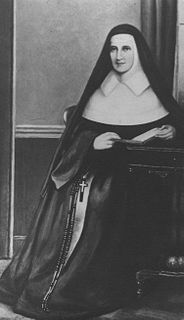
The Sisters of Mercy is a religious institute of Catholic women founded in 1831 in Dublin, Ireland, by Catherine McAuley. As of 2019, the institute had about 6200 sisters worldwide, organized into a number of independent congregations. They also started many education and health care facilities around the world.
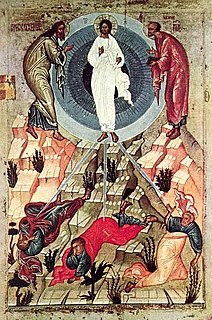
Catherine Labouré was a French nun who was a member of the Daughters of Charity of Saint Vincent de Paul and is a Marian visionary. She is believed to have relayed the request from the Blessed Virgin Mary to create the famous Miraculous Medal of Our Lady of Graces worn by millions of people around the world. Labouré spent forty years caring for the aged and infirm. For this, she is called the patroness of seniors.

Catherine McAuley was an Irish religious sister who founded the Sisters of Mercy in 1831. The women's congregation has always been associated with teaching, especially in Ireland, where the sisters taught Catholics at a time when education was mainly reserved for members of the established Church of Ireland.
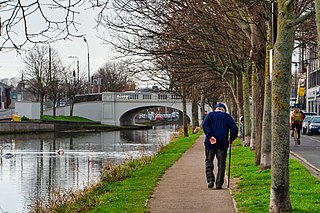
Harold's Cross is an urban village and inner suburb on the south side of Dublin, Ireland in the postal district D6W. The River Poddle runs through it, though largely in an underground culvert, and it holds a major cemetery, Mount Jerome, and Our Lady's Hospice.

Many religious communities have the term Sisters of Charity in their name. Some Sisters of Charity communities refer to the Vincentian tradition, or in America to the tradition of Saint Elizabeth Ann Seton, but others are unrelated. The rule of Vincent de Paul for the Daughters of Charity has been adopted and adapted by at least sixty founders of religious institutes for sisters around the world.

Mother Mary Frances Aikenhead was born in Daunt's Square off Grand Parade, Cork, Ireland. Described as one of nursing's greatest leaders, she was the founder of the Catholic religious institute, the Religious Sisters of Charity, the Sisters of Charity of Australia, and of St. Vincent's Hospital in Dublin.
Mother Frances Mary Teresa Ball was the foundress of the Irish Branch of the Institute of the Blessed Virgin Mary (IBVM).

St Columba's College is an all-female Roman Catholic secondary school in the Melbourne suburb of Essendon.

The Order of Our Lady of Charity is a Roman Catholic monastic order, founded in 1641 by John Eudes, at Caen, France, and known for profitably overseeing the slavery-like conditions in the Magdalene Laundries in Ireland for which Ireland has apologized to the victims.
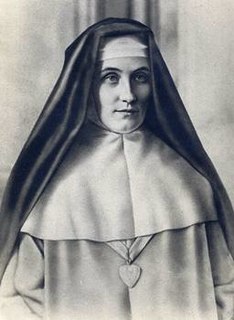
Mary of the Divine Heart, born Maria Droste zu Vischering, was a German noblewoman and Roman Catholic nun of the Congregation of Our Lady of Charity of the Good Shepherd, best known for having influenced Pope Leo XIII to make the consecration of the world to the Sacred Heart of Jesus. Pope Leo XIII himself called the solemn consecration "the greatest act of my pontificate".
The Religious Sisters of Charity or Irish Sisters of Charity is a Roman Catholic religious institute founded by Mary Aikenhead in Ireland on 15 January 1815. Its motto is Caritas Christi urget nos.

Our Lady's Hospice & Care Services is a hospice and health care provider with two locations: one at Harold's Cross, Dublin and a satellite facility at Blackrock, County Dublin in Ireland. It provides specialist care for people with a range of needs from rehabilitation to end of life care.
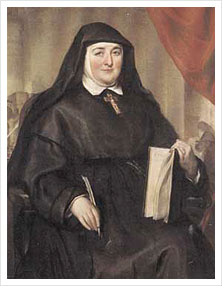
The Sisters of Charity of Australia is a congregation of religious sisters in the Catholic Church who have served the people of Australia since 1838.
Sarah Atkinson was an Irish writer, biographer, essayist and philanthropist.

Sister Katherine Butler was an Irish nun with the Religious Sisters of Charity, teacher, writer, and aviator. Butler was one of the first women to get a pilot's licence in Ireland.
Anna Maria Ball was an Irish philanthropist.
Catherine Cummins or Mother Mary Polycarp was an Irish Sister of Charity nun and founder member of Cappagh Orthopaedic Hospital.
Mary May Scollen (1887–1967), known by her religious name as Sister Mary Justinian, was an Australian religious who was notable for her nursing and hospital administration. She joined the North Sydney congregation of the Sisters of Mercy, professing final vows in 1907. Trained as a nurse, she served as matron of the Mater Misericordis Hospital in the north Sydney area, for 44 years. She then served as hospital administrator for four years, and concurrently was the superior for her convent. She was appointed M.B.E. in 1958.
Ellen O'Doherty (1894–1983), known by her religious name as Sister Mary Alphonsus, was an Australian religious who became the superior general of the Sisters of Charity of Australia. She was a skilled nurse and hospital administrator, and worked in many of the order's hospitals, contributing to the growth and successful operations of these facilities.
Mary John Baptist De Lacy, was an Irish-born Sister of Charity, and one of the first religious sisters to come to Australia. She was one of five Sisters of Charity who arrived in Sydney in 1838 to serve poor women convicts. She founded and managed the St. Vincent Hospital in Woolloomooloo. She lived in Australia until 1859, when she returned to Ireland, spending her final years in the Sisters of Charity Mother House in Dublin.
References
- 1 2 3 4 5 6 O'Leary, Marie (2009). "Gaynor, Anna ('Sister Mary John')". In McGuire, James; Quinn, James (eds.). Dictionary of Irish Biography . Cambridge: Cambridge University Press.
- 1 2 "Our Heritage". Our Lady's Hospice. Retrieved 11 March 2020.
- ↑ Clark, David (2016). To comfort always : a history of palliative medicine since the nineteenth century (First ed.). Oxford: Oxford University Press. p. 37. ISBN 978-0191656019.
- ↑ "Tours of Mary Aikenhead Heritage Centre, The Hospice". Harold's Cross. 10 April 2015. Retrieved 11 March 2020.
- ↑ Lewis, Milton James (2007). Medicine and care of the dying : a modern history. Oxford: Oxford University Press. p. 20. ISBN 978-0195175486.